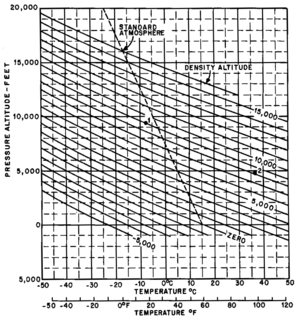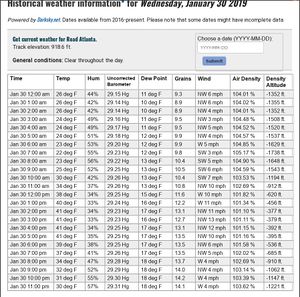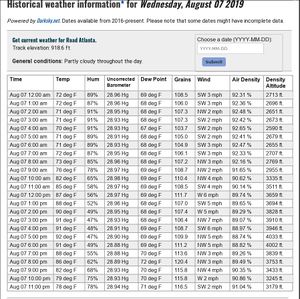Density Altitude
From WindsportAtlanta.com: Wiki
Description
The density altitude is the altitude relative to standard atmospheric conditions at which the air density would be equal to the indicated air density at the place of observation. In other words, the density altitude is the air density given as a height above mean sea level. The density altitude can also be considered to be the pressure altitude adjusted for a non-standard temperature.[1]
Pressure Altitude is the height above a standard datum plane (SDP), which is a theoretical level where the weight of the atmosphere is 29.92 "Hg (1,013.2 mb) as measured by a barometer.
Effect
Density Altitude is a way to compare air density over a range of conditions. The more dense air is, the more power wind has. Generally, it is a linear relationship.
Factors that affect density altitude are
- local air pressure which varies with weather systems. For example, tropical systems are notable for lower pressures and cold fronts for higher pressures
- air temperature. Warmer air is less dense. Thus there is a significant difference in the power of wind from a 40 degree winter day to 95 degree summer day.
- altitude, the higher you go, the less dense the air is. Lake Lanier is approx. 1070 ft above sea level which all other factors being equal means
- humidity. More humid air is less dense - water molecules weigh less than other air gases including nitrogen and oxygen.
The screenshots of a winter's day compared to a summer's day show how the air can be up to 15% more dense in the winter. Or, your 6.5 now has the power of a 7.8! Conversely, on that hot summer day, you'd need a 9.2 to have the same power as a 7.8 on a cold winter's day.
You can use the NWS calculator to play with the numbers to see how the different factors affect the air density.
Sources and Links
- Density Altitude at Road Atlanta (proxy for Lake Lanier)
- Density Altitude at Road Atlanta Yesterday
- Weather.gov Density Altitude Calculator Requires actual pressure, temp and humidity
- Density Altitude on Wikipedia
- Pressure Altitude on Wikipedia


